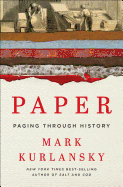
Mark Kurlansky, the master of exploring history through the lens of a single object (Salt; Cod), pens another such striking work in Paper: Paging Through History. Kurlansky maintains that technology does not change society, but is a response to new needs inspired by changes already in progress. Thus when a civilization needed portable, widespread and relatively cheap forms of written communication, paper became popular. This explains why the widely literate medieval Muslims embraced paper when the widely illiterate Europeans did not--it wasn't that paper was unknown to Europe, but that writing material based on animal skins (expensive and slow solutions like parchment or vellum) suited their needs at the time. Later, in the early Renaissance, when Europeans needed the advantages of paper, they adopted papermaking, and when they needed to reproduce written work more quickly, they invented the printing press.
The history of what we consider paper (a sheet of pulped fibers pressed into a mold and dried) extends back only to roughly 2nd-century China. The development of paper spread from there in fits and starts, and sometimes independently--the Aztecs had a form of paper, though most examples were destroyed by the Spanish. Paper draws together nearly all corners of world history. As he has done so successfully before, Kurlansky weaves seemingly disparate topics into a cohesive narrative, at once full of interesting trivia and sweeping social trends. Art, literature, religion, economics, technology, science--the list of topics touched by Paper is as extensive as the book is fascinating. Each flip of Paper's pages brings a fresh appreciation for the paper page itself. --Tobias Mutter, freelance reviewer

